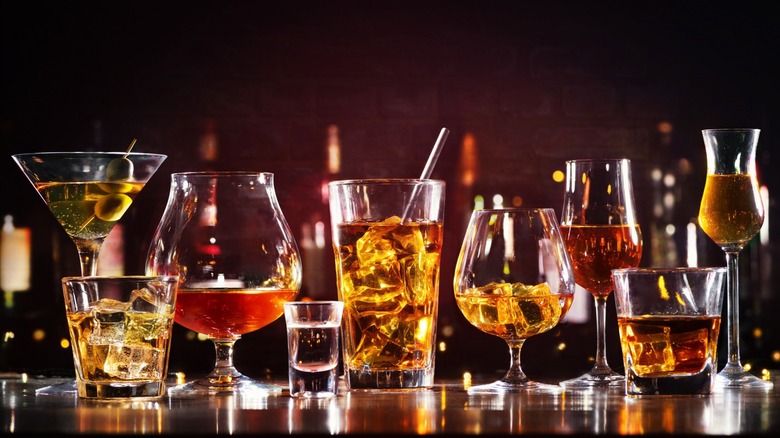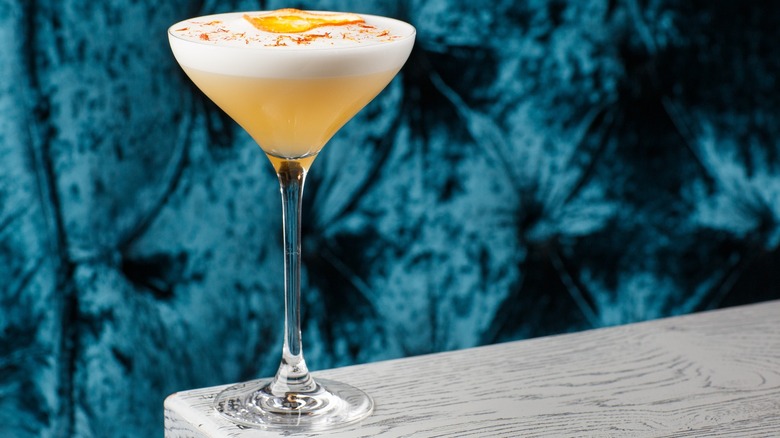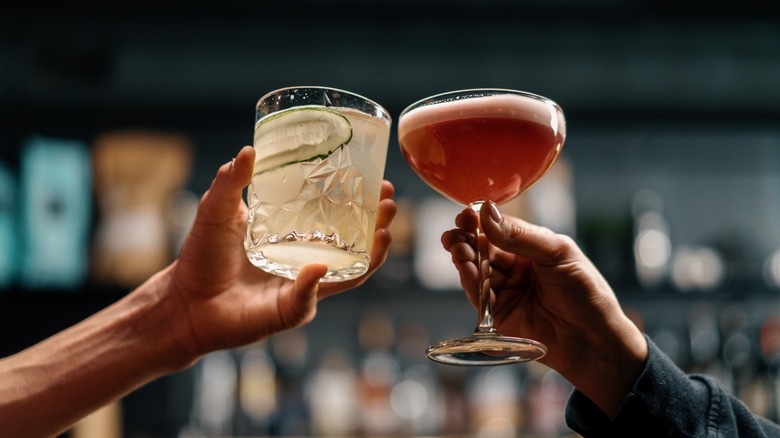The Glassware Mistake That Might Be Ruining Your Cocktail Experience
Picking the right shape and size of glass for your cocktail can make a big difference. Before you start mixing, keep fluid ounce capacity in mind, and make sure that your choice of glassware fits the volume of the cocktail well. You don't want the drink to be spilling over the sides the moment you pick it up, and you also don't want the glass to look like it's half empty. For example, a two-finger pour of whiskey on the rocks will occupy less physical space than, say, a frozen watermelon mezcal margarita. That said, with all the different cocktail glassware shapes available, it can be a little confusing to know where to begin. Let's break it down.
In the bartending industry, particularly in more laid-back establishments like local dive bars and watering holes, glassware is often used as a speedy measuring tool for assembling drinks. During a rush, bartenders know that a two-parter highball like a G&T can be easily made in a highball glass — just fill it with a generous scoop of ice, pour the gin over the ice until the glass appears roughly halfway full, then top it off with tonic. Although, don't get it twisted. Highball glasses work just as well for tried-and-true workhorses like whiskey sodas and rum and Cokes as for elevated cocktails like anéjo-lime-ginger beer highballs.
Coupe it simple
Martini glasses are effortless to sip from. The drink spills easily into the mouth with the slightest elevation of the v-shaped glass, making this a great choice of glassware for drinks with thinner mouthfeels, minimal ingredients, and no carbonation or ice, like Cosmopolitans, Aviations, and (of course) Martinis. Although, they're not always able to accommodate cocktails with larger volumes and more complicated ingredients.
With their wide rims and versatile breathability, coupe glasses are an ideal all-purpose glass for assembling creative cocktails and mocktails. Sizes vary, but they tend to clock in at around the 6-fluid-ounce capacity, which can help you visualize your ratios of ingredients without accidentally overdoing it on the liquor. The curved bottom helps fizzy drinks keep their bubbles, and their medium-low center of gravity helps prevent accidental spills (which can be a huge bonus after drinking a Corpse Reviver #2).
Alternatively, if you want to keep it slightly smaller or showcase a delicate stirred cocktail, the 4-to-6-ounce Nick and Nora glass is your best friend. It's classic, easy to hold, and great for reducing hand warmth exposure for cocktails served without ice, like a Gimlet or Pisco Sour. Their smaller size also minimizes the air left in the glass around the drink's surface, which keeps it chilled for longer.
Old fashioned glasses prove that there's no school like the old school
Use an old fashioned glass, also known as a rocks glass, for any neat pour or spirit on the rocks. Rocks glasses are also good for punchy, spirit-forward drinks in which a visually smaller glass can help home bartenders avoid psychosomatically overfilling a larger glass with too much booze. Manhattans and Negronis are delish, but too much of a good thing can be a bad thing (and can ruin the taste, alongside). You could also try the 8-to-10-ounce double rocks glasses, which can be more customizable for your unique cocktail purposes (we're looking at you, huge-fancy-ice-ball fans).
Their understated, minimal appearance and wide, sturdy rims also make rocks glasses a great choice for letting standout garnishes shine, like edible herbs and botanicals, candied orange wheels, and floral sugar rims. Even though they might appear pretty similar, rocks glasses and stemless wine glasses are not necessarily interchangeable. For example, high-proof, neat spirits can be too harsh when served in a glass with a tapered rim.
At the end of the day, the glass you choose to drink out of should make you happy — happy to hold, to look at, and to sip from. If you're looking to streamline your home bar cabinet, a good coupe glass, rocks glass, and highball glass can cover a myriad of uses. But knowing your cocktail's volume as you select the right tool for the job might be all it takes to elevate your home mixology game to the next level.


